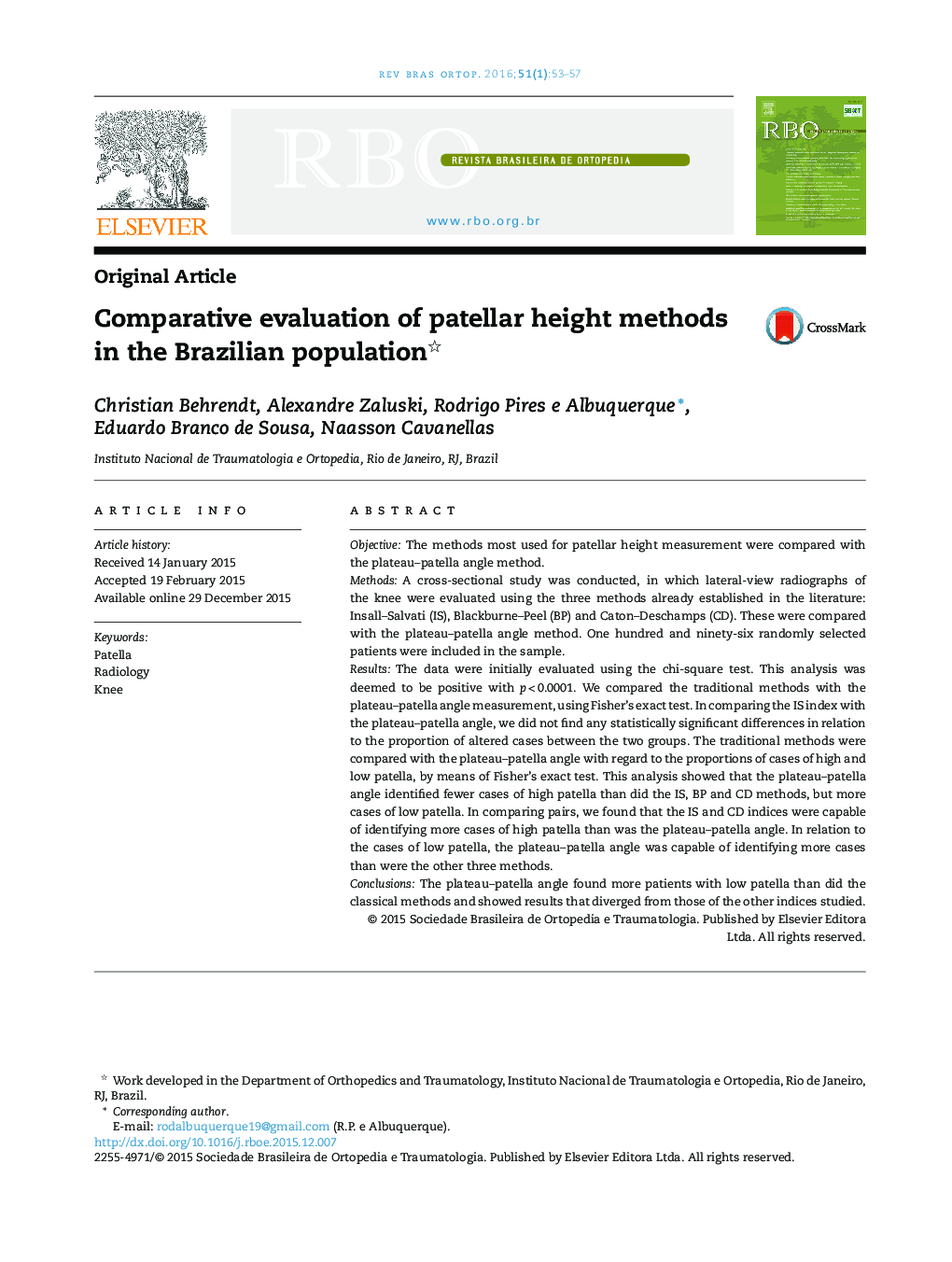| کد مقاله | کد نشریه | سال انتشار | مقاله انگلیسی | نسخه تمام متن |
|---|---|---|---|---|
| 2713436 | 1145157 | 2016 | 5 صفحه PDF | دانلود رایگان |
ObjectiveThe methods most used for patellar height measurement were compared with the plateau–patella angle method.MethodsA cross-sectional study was conducted, in which lateral-view radiographs of the knee were evaluated using the three methods already established in the literature: Insall–Salvati (IS), Blackburne–Peel (BP) and Caton–Deschamps (CD). These were compared with the plateau–patella angle method. One hundred and ninety-six randomly selected patients were included in the sample.ResultsThe data were initially evaluated using the chi-square test. This analysis was deemed to be positive with p < 0.0001. We compared the traditional methods with the plateau–patella angle measurement, using Fisher's exact test. In comparing the IS index with the plateau–patella angle, we did not find any statistically significant differences in relation to the proportion of altered cases between the two groups. The traditional methods were compared with the plateau–patella angle with regard to the proportions of cases of high and low patella, by means of Fisher's exact test. This analysis showed that the plateau–patella angle identified fewer cases of high patella than did the IS, BP and CD methods, but more cases of low patella. In comparing pairs, we found that the IS and CD indices were capable of identifying more cases of high patella than was the plateau–patella angle. In relation to the cases of low patella, the plateau–patella angle was capable of identifying more cases than were the other three methods.ConclusionsThe plateau–patella angle found more patients with low patella than did the classical methods and showed results that diverged from those of the other indices studied.
ResumoObjetivoComparar os métodos mais usados de medida da altura patelar, com o método do ângulo platô-patela.MétodosFoi feito um estudo transversal no qual foram avaliadas radiografias em perfil do joelho, com os três métodos já consagrados pela literatura, o Insall-Salvati (IS), o Blackburne-Peel (BP) e o Caton-Deschamps (CD) e comparando-as com o ângulo platô-patela (APP). Foram incluídos na amostra 196 seis pacientes, aleatoriamente selecionados.ResultadosInicialmente os dados foram submetidos a uma avaliação pelo teste do qui-quadrado. A análise foi positiva com p < 0,0001. Fizemos comparações entre os métodos tradicionais com a medida do APP com o uso do teste exato de Fisher. Quando comparamos o índice de IS com o APP, não encontramos diferenças estatisticamente significativas em relação à proporção de casos alterados entre os dois grupos. Os métodos tradicionais foram comparados com a medida do APP quanto à proporção de casos de patela alta e baixa pelo teste exato de Fisher. A análise demonstrou que o APP identificou menos casos de patela alta do que os métodos de IS, BP e CD, mas identificou mais casos de patela baixa. Quando comparados os pares, verificamos que os índices de IS e CD foram capazes de identificar mais casos de patela alta que o APP. Em relação aos casos de patela baixa, o APP foi capaz de identificar mais casos que os outros três métodos.ConclusãoO ângulo platô-patela observou mais pacientes com patela baixa em comparação com os métodos clássicos e resultados discrepantes com os outros índices estudados.
Journal: Revista Brasileira de Ortopedia (English Edition) - Volume 51, Issue 1, January–February 2016, Pages 53–57
